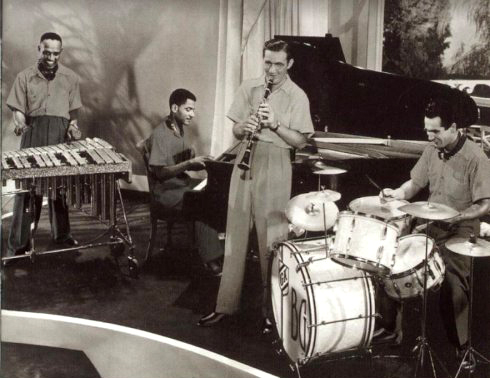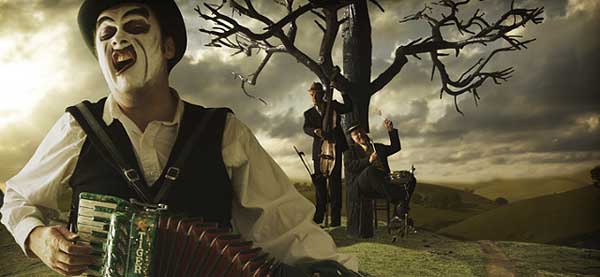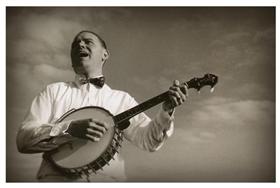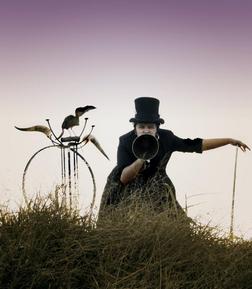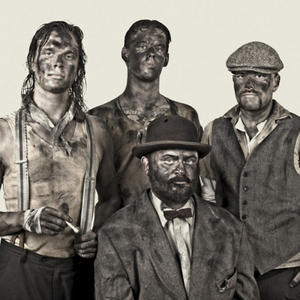Tim has asked about DJing for beginners, so I’m going to talk about the set I did last Friday at the Swingpit here in Sydney. Once again I’ll disclaim: this is just my opinion, not gospel, people will disagree and that’s a good thing, etc etc etc.
DJing for new dancers: my approach, and a case study
Firstly, my general rule for DJing, for anyone, is “everyone should dance, and everyone should have a really good time.” There are other rules: “make it easy to have fun” and “don’t try to ‘teach’ anyone anything or ‘test’ dancers”. Just get up there and DJ that badass shit, motherfucker.
I find that DJing for new dancers is a bit like leading a new dancer. Do your very best work. And make it easy for everyone to have fun. So avoid the stunts, avoid the tricks, play good songs, do nice stuff and enjoy yourself. There’s a reason we have favourite songs, and a reason we have ‘basic’ or foundational or fundamental steps. The swingout is generally considered the ‘foundational’ step for lindy hop (this is of course debateable, but let’s talk about that another time, huh?), and I take it as a model for my DJing.
It should swing.
I wouldn’t play neo for advanced dancers, so why would I play it for new dancers? It’s shit. Don’t play it. Same goes for rock and roll, slow groovy blues and so on. Play good, solid swinging jazz. Because it’s both awesome and also challenging and interesting. It’s also new to new dancers, for the most part, so introduce them to your very best friends. Your best friends are the ones you like the most, the most forgiving, the kindest and the funnest. You have other friends, but these are the ones you’ll take to this particular party.
There are no rules about tempo.
Some people think you should only play slow songs for new dancers. I think that’s bullshit. You wouldn’t play only fast songs for experienced dancers, so don’t insult your noobs. But this does highlight an important point: new dancers don’t have good lindy hop fitness. Even if they’re super fit athletes already. Lindy hop kicks your arse and requires good motor skills, balance and coordination. All with a strange person. So it’s quite tiring when you’re just beginning. So remember when you’re DJing for new dancers, that they’ll get tired quickly. This brings me to the next important point…
Work that goddamn wave.
Move through the tempos (120-140-160-180-200 and down again) quickly and efficiently. Don’t do crazy jumps (120-200), but don’t linger at a particular tempo. You can do a bit more time in the < 160 territory if people are especially tired, but don't sit down there too long. You might want to restrict your highest tempo if you're DJing a particularly tired group of new dancers, but do NOT assume that they don't want to dance fast. No one's told them a song is 'too fast' yet, so they'll have a go at anything. Which is WONDERFUL and something experienced dancers don't do any more.
All this is really just good DJing practice. Working the tempos helps you work the energy in the room, and also the emotions in the room. I like to build to a crescendo (to a climax, or to the punchline of a good joke), where half the pleasure lies in the expectation. So building up is as important as arriving.
Work with emotions and energy.
I do tend to avoid the overly sexy songs or songs that feel sexy, mostly because new dancers are often uncomfortable dancing close to strangers and sexy songs adds to that discomfort. Especially in mixed age groups. I also lean a bit on the cheery songs (rather than the moodier stuff), but then, that’s lindy hop. It’s meant to be a big, fat kick of adrenaline and happyjoyjoy. It could be manic or kind of arsekicking happyjoyjoy, but it’s still a good feeling. I take Frankie as a model: he used to aim to make a woman laugh when he danced with her. And I reckon it’s a good approach. He might’ve been doing it to get laid, but I’m doing it to have a good time for a more ordinary sort. I want to see dancers on the floor and sidelines laughing and smiling. Not cranky.
Play your best songs.
Not your newest, strangest songs or songs you’re not really sure of. Play your best songs. This can be a hard one, especially if you’re a new DJ and not really sure what constitutes ‘best’. For my money, the ‘best’ songs are often the favourites. The Lincoln Centre Jazz Orchestra playing ‘C Jam Blues’ is a best song. It’s a bloody good band recorded live, playing a bloody good song at an accessible tempo. It has lots of energy. It has fun breaks. It’s good. It’s ok to play old, overplayed favourites for new dancers. They’re favourites for a reason. And they’re not ‘old’ to new dancers – they’re new. You’re introducing new dancers to your best friends, right? So introduce them to the songs people love. As The Squeeze says “I’m here to have a good time. Play good songs, and play some songs I know.”
I’m not saying don’t ever play a new or untested song to new dancers. I found, DJing the Funpit in Melbourne, that I’d often test my newer stuff on those guys because they were up for ANYTHING, so long as it was fun. But I try to cushion the songs I’m not sure of. Build up with a safe song, follow up with a safe song. So I’d prepare the crowd for something new and strange with ‘C Jam Blues’ and have something like ‘Apollo Jump’ on hand in case it bombed. If it went well, I’d follow up with something else, perhaps go in a new direction stylistically or otherwise take another risk. Try to figure out what they liked in the song.
Try to go easy on song length.
This isn’t a hard and fast rule. But newer dancers do tend to lack stamina, and new leads can get a bit sick of their same 3 moves, and new follows can suddenly figure out 1 minute into a song why no other woman will dance with that unpleasant older man. So cut them some slack and play shorter songs.
Live bands.
I do not, however, support the suggestion that live bands should follow any of these rules (except for the neo one – don’t play that shit. It’s nasty. Unless you are actually a neo band. Then I probably won’t be at your gig). Long songs = important for bands because they give musicians a chance to improvise and shine. I tend to drop the 2-dance rule when I’m dancing to really long songs.
What else? Hmmm. Be prepared for new dancers to come running up to say “What was that song?!” and then to have to explain who Ella Fitzgerald is.
Oh yeah.
Be aware of the music in the class before the social dancing, if you’re DJing after a class.
This is a big one. I try to give half an ear to what they’re teaching in the class, and what music they’re using. This can be hard if they’re using neo to teach dodgy stuff. But what I might think is ‘oh, I’ll play hi-fi stuff with lots of energy and probably vocals’. Because that’s what people like about neo. They also tend to like its non-swingingness because it’s familiar (and more like rock n roll or punk or whatever). But I won’t pander to that. I will perhaps play some upenergy jump blues, but I won’t play neo. Yucky.
If they’re teaching with really really really slooooow music, then you’re going to have some trouble getting the tempos up later on. If you come in with something at 160 after they’ve been learning at 112 (welcome to my recent DJing life), you’re going to scare them. So come in a bit slower. But get the tempos up. Don’t sit down there on 112. That’s bad news. Because you’re introducing new dancers to your best friends, remember? And you have more friends than just ‘Night Train’, right? RIGHT?
I try to match the feel and the energy and the style of the last song they play in class. Which is where I segue to my last set….
First set @ Swingpit, Friday 13th August 2010
title – artist – album – bpm – year – song length
My Baby Just Cares For Me Nina Simone The Great Nina Simone 120 3:38
Let’s Do It Terra Hazelton (feat. Jeff Healey, Marty Grosz, Dan Levinson, Vince Giordano) Anybody’s Baby 126 2004 4:28
Massachusetts Maxine Sullivan With Buster Bailey, Milt Hinton, Jerome Richardson, Osie Johnson, Dick Hyman, Wendell Marshall A Tribute To Andy Razaf 147 1956 3:19
For Dancers Only Jimmie Lunceford and his Orchestra Swingsation – Jimmie Lunceford 148 1937 2:41
Walk ‘Em Buddy Johnson and his Orchestra Walk ‘Em 131 1946 2:53
Cole Slaw Jesse Stone and His Orchestra Original Swingers: Hipsters, Zoots and Wingtips vol 2 145 2:57
Jump Through The Window Roy Eldridge and his Orchestra (Zutty Singleton) After You’ve Gone 154 1943 2:42
Big Fat Mama Lucky Millinder and his Orchestra (Trevor Bacon, Buster Bailey) Apollo Jump 135 1941 3:09
Leap Frog Louis Armstrong and his Orchestra (Luis Russell) The Complete Louis Armstrong Decca Sessions (1935-1946) (disc 7) 159 1941 3:00
Stuffy Jonathan Stout and his Campus Five Jammin’ the Blues 153 2003 3:46
Blues In Hoss’s Flat Count Basie and his Orchestra Chairman Of The Board [Bonus Tracks] 144 1958 3:13
Blue Monday Jay McShann and his Band (Jimmy Witherspoon) Goin’ To Kansas City Blues 125 1957 3:40
Gimme A Pigfoot Lavern Baker La Vern Baker Sings Bessie Smith 120 1958 3:11
The Spinach Song Terra Hazelton (feat. Jeff Healey’s Jazz Wizards) Anybody’s Baby 165 2004 4:57
San Francisco Bay Blues Lu Watters’ Yerba Buena Jazz Band with Barbara Dane Blues Over Bodega 160 1964 3:42
You Can Have My Husband Tuba Skinny (Erika Lewis, Todd, Kiowa, Shaye Cohn, Barnabus, Alynda Lee, Robin) Tuba Skinny 144 2010 3:49
Bizet Has His Day The Solomon Douglas Swingtet Ain’t No School Like the Old School 155 2010 3:44
Twenty Four Robbers Gordon Webster (with Brianna Thomas, Jesse Selengut, Matt Musselman, Adrian Cunningham, Cassidy Holden, Rod Adkins, Jeremy Noller) Happy When I’m With You 209 2009 2:39
Yacht Club Swing Echoes of Swing Harlem Joys 164 2008 3:20
Be Careful (If You Can’t Be Good) Buddy Johnson and his Orchestra Walk ‘Em 121 1951 3:09
Long Gone John Gordon Webster (with Brianna Thomas, Jesse Selengut, Matt Musselman, Adrian Cunningham, Cassidy Holden, Rod Adkins, Jeremy Noller) Happy When I’m With You 140 2009 3:57
Solid as a Rock Count Basie and his Orchestra with The Deep River Boys Count Basie and His Orchestra 1950-1951 140 1950 3:04
The teachers had been using CW Stoneking’s ‘Don’t Go Dancin’ (from King Hokum) which I initially thought was a bad idea, until I saw the routine. It was Friday 13th and they were doing a ‘spooky’ routine which was actually quite fun. The students were _really_ enjoying it, and would go from quiet and attentive during demonstrations to raucous and rowdy during rotations to new partners.
So I began with ‘My Baby Just Cares For Me’ because ‘Don’t go Dancin” is just vocals + a bit of rinky tink uke action. Difficult dancing. I chose ‘My Baby Just Cares For Me’ because it’s also sparse instrumentation. The piano dominates, with a nice, simple walking bass line and the vocals are delivered quite simply and plainly. It’s a mood change, but it still works in much the same ways as ‘Don’t Go Dancin”. I wanted to change the mood because I couldn’t stay down there in moody land. But I did want to use the clutch while changing gears. ‘My Baby Just Cares For Me’ about the same speed, but it builds in energy. It’s an old favourite. It’s fun to dance to because of the breaks, and because the piano is actually quite clever (go Nina, Go!) and allows room for jokes. I like it. It’s overplayed because it’s good. New dancers love it. They also recognise it because of the claymation video clip that used to get played on Rage a lot.
I played ‘Let’s Do it’ because it’s another iconic jazz song. Most people know it. It’s saucy, but not in an up-in-your-grill way. This version is hi-fi and fun. Same slow tempo, because I’m still prepping the room. I’m playing nice, to get everyone up and feeling good and comfortable. This song went down really really well.
‘Massachusetts’ is another overplayed gem. It’s good. It starts simply, but it has a lovely, chunky rhythm that’s easy to dance to. It’s a little faster, but not crazily so. It’s funness and easiness actually makes people dance, even though it is faster. With bubs, at this point, I want to convince them to try to dance, to get some endorphines, and then to decide they like dancing. So I play nice at this early point.
All three of these have lyrics. Which is good for people who never listen to jazz. They’re all women, so they link. They all have quite conventional deliveries, which is also useful (no Cangelosi Cards just yet). All this action is safe. But there’s no fucking Buble here. This is good stuff. I’m warming the room.
‘For Dancers Only’ is a switch to a big band, because I wanted a bigger sound. It’s another old favourite. It’s also overplayed. It went well. It also worked as a trigger for the social dancers who’d arrived (and I noticed there were quite a few there that night – far more than the students from the class).
I wanted to play nice, so I went down a few bpm to ‘Walk em’, which is a song I think of as a ‘beginner song’, partly because of Johnson’s comments in the liner notes of that album about playing slower songs for inexperienced dancers. It worked, and filled the flor a little more.
‘Cole Slaw’ – more overplayedness. But clapping. At an easy tempo, but a little higher than ‘Walk em’.
‘Jump Through the Window’. Yes, just assume that I’m playing all overplayed favourites unless I say othewise, ok? This had mixed results. The squawky trumpet kind of blew up the sound quality and this song really demonstrated the limitations of the sound gear at that venue. Boo. It sounded squawky and without enough sound in the mid range. I fiddled with the equaliser, but it wasn’t really going to do much good. I resisted the urge to pump the volume so I could ‘hear’ the mids, because that doesn’t actually work.
Back down the tempos again, but playing ‘Big Fat Mama’ because it has vocals and is fun and accessible. Still a big band.
….I’m losing interest in this post, actually, so I can’t really be bothered writing any more. The only thing worth pointing out is that I should have skipped that version of ‘Yacht Club Swing’ (or replaced ’24 Robbers’ with it) and gone straight to the lower tempoed Fats version of ‘All That Meat and No Potatoes’ I’d intended, instead of pushing a smart arse Fats theme (they’re all Fats Waller songs). Too fast.
Also, that version of ‘Bizet has his day’ bombed. I thought it might work because it has clapping. And I remembered it as being the most appropriate from Sol’s new album for this crowd. I was wrong. I had set it up properly with the upenergy ‘San Francisco Bay Blues’ and then the mellower ‘You Can Have My Husband’, as ‘Bizet Has his Day’ starts mellow and then builds. But it just bombed. Listening, I thought ‘oo, this isn’t that good a song’. I find the solos a bit intrusive and annoying and the transitions between solos are a little clunky. It’s a bit of an unusual song, but I had set it up properly. I’ll try it again, but not soon (sorry Sol).
The second half of the set was mostly newer or less familiar songs, and they had mixed results with the new dancers. But by that point there was a more mixed crowd, so I wanted to change things. the Terra Hazelton and Tuba Skinny are going down really well (both here and at Canberrang) and they’re a nice combination.
We ended on a birthday/farewell jam and then I danced a couple of songs before suddenly discovering I had A SICK STOMACH and having to rush home to bed. That sucked ARSE and was entirely unexpected. I was feeling fine and wanted to DANCE. A big BOO to that.

